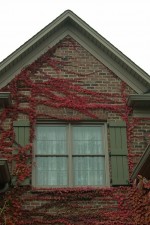When we moved from an old historic brick house in Annapolis to the brand new brick house in North Carolina we were not thrilled with the starkness of the look and missed the ivy covered walls to which we were accustomed. No, problem; the head gardener ordered Boston Ivy (not really an ivy) and within one year our house looked as though it had been on its site for years. After another year we were also treated to the magnificent scarlet autumn foliage of this spectacular vine. And no, this vine does not hurt the mortar or brick of the house; it climbs by producing branched tendrils equipped with sticky disks that do not penetrate the surface. (It may, however, hurt painted surfaces.) This vine is deciduous (drops its leaves) and in the winter so its woody leafless stems adorn our house with beautiful patterns. Note that the vine shades your house in summer reducing air conditioning costs, but lets the sun through in winter warming your house and decreasing heating costs.
Type: Woody deciduous vine.
Outstanding Feature: Scarlet foliage in autumn; stem pattern in winter.
Growth Rate: Rapid.
Bloom: Inconspicuous but followed by small dark blue berries attractive to some birds.
Size: To 60’.
Light: Full sun to light shade.
Soil: Slightly moist to slightly dry conditions; fertile loamy soil; tolerates soil containing clay or stony material.

Hardiness: Zones 4-9.
Pests and Diseases: Mildews can be a problem; Japanese beetles can damage leaves but plants usually recover.
Propagation: Softwood cuttings late spring to early summer.
Comments: Tolerates city conditions.

[…] The most familiar are probably the little roots that form along an ivy stem that allow it to grow up a wall, fence or other structure. These aerial roots are probably not […]